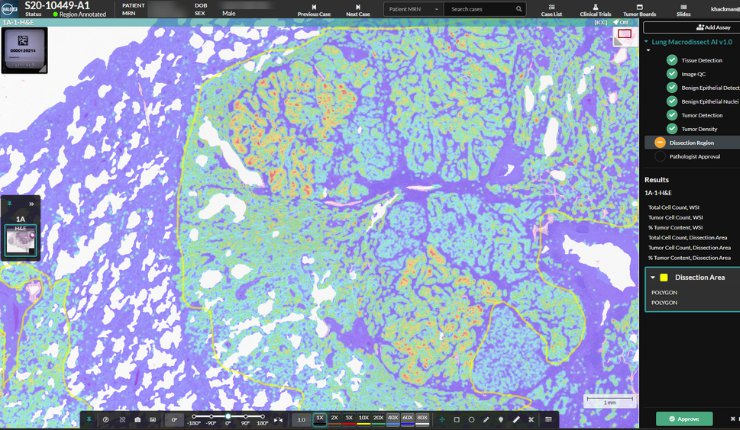Indica Labs, a leading provider of AI-powered digital pathology solutions, has announced the launch of Lung Macrodissect AI, a tool that the company says ‘revolutionises’ slide macrodissection and molecular pathology workflows.
The company says Lung Macrodissect AI represents a significant leap forward for the integration of artificial intelligence with digital pathology by offering pathologists a streamlined macrodissection workflow that minimises human error and improves efficiency.
Lung Macrodissect AI is deployed in HALO AP, quantifies tumour content, streamlines tumour annotation, and ensures specimen quality for downstream analysis according to Indica.
Tumour content estimation and macrodissection are critical steps in molecular pathology, involving the assessment of tumour content within a sample and the precise isolation and removal of tumour regions for downstream molecular analysis. Existing manual methods are subjective, error-prone, labour-intensive, and lack auditability.
Indica Labs says its HALO Macrodissection Solutions suite addresses these challenges by quantifying tumor content across the entire whole slide image and generating real-time information about the quantity of tumour cells within annotated regions.
Tumour cell density heatmaps highlight tumour-rich regions, aiding the annotation process. Lung Macrodissect AI quantifies and standardises tumour content assessment, reducing subjectivity and errors while streamlining the macrodissection annotation process for both primary and metastatic non-small cell lung cancer cases.
Read more: Indica Labs receives first FDA clearance for HALO AP Dx digital pathology platform
Lung Macrodissect AI integrates into HALO AP, the enterprise digital pathology platform from the company, and can be combined with the Tissector line of robotic macrodissectors from our partner, Xyall, for an automated and audited workflow. This integration enhances the accuracy of the macrodissection process and increases throughput and operational efficiency, freeing pathologists to focus on more complex tasks. The tool can also be used to guide and standardise manual macrodissection workflows.
“We’re excited to offer pathologists an alternative to the current time-consuming, labour-intensive process of macrodissection. Our macrodissection AI models significantly advance the field of molecular pathology,” said Steven Hashagen, CEO of Indica Labs. “Lung Macrodissect AI is part of a larger suite of macrodissection tools, with additional product launches planned for colon, breast, and prostate. These products significantly enhance macrodissection workflows and make genetic testing more accessible, accurate, and affordable.”
Beyond highlighting cancerous tissue, Lung Macrodissect AI calculates the total number of tumor cells present within an annotated region of interest (ROI) and determines the percentage of tumor present in all annotated ROIs. This ensures that only adequately concentrated specimens are sent for expensive downstream genetic sequencing and molecular testing. By standardising the enrichment process, Lung Macrodissect AI improves the overall quality and reliability of macrodissection workflows while streamlining the process in its entirety and enhancing efficiency.
“The current manual methods of tumor content estimation and macrodissection are subjective and prone to error,” said Peter Caie, Senior Principal Scientist in the AI Diagnostics group at Indica Labs. “Pathologists spend a significant amount of time meticulously examining slides and annotating regions of interest by hand, a process that is both tedious and demands immense effort on the part of laboratory staff. Lung Macrodissect AI advances the process of slide macrodissection by accurately and objectively quantifying every cell across a whole slide image, guiding and simplifying the annotation process and automatically reporting the tumor content within said annotation in real-time.”
Clinical validation was conducted on 317 primary and metastatic whole slide images from an external site that were previously unseen to the algorithm. Comparing five pathologists’ tumour content estimations with and without assistance from Lung Macrodissect AI revealed significant improvements in agreement and consistency when aided by the algorithm. Without AI assistance, the consistency between pathologists (ICC) was relatively low at 0.45.
The agreement measure (Fleiss’ kappa) when specimens were binarised using a 20% tumour content cut-off, the minimum requirement for most molecular tests, was also low at 0.27. With AI assistance, the ICC score increased to 0.75, and the Fleiss’ kappa statistic rose to 0.66, indicating a ‘substantial and significant’ improvement in consistency of tumour content estimation across pathologists.









